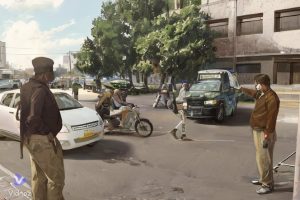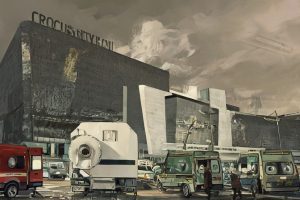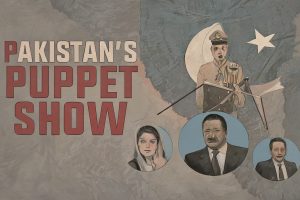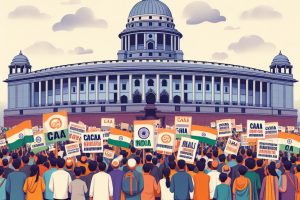By Shah A Siddiqui
It was mid-summer of 1986 when I decided to go to Karakow and Oswiecm (Auschwitz) with my family for sightseeing and also to explore the history of the Nazi extermination camp and salt mine of Weiliczka in Krakow. Krakow was only 191 miles away, or a three and a half hour drive from Warsaw, where I resided briefly in my years of traveling the world for work.
also to explore the history of the Nazi extermination camp and salt mine of Weiliczka in Krakow. Krakow was only 191 miles away, or a three and a half hour drive from Warsaw, where I resided briefly in my years of traveling the world for work.
We reached our hotel in Krakow on a Saturday around noon and began our excursion shortly after, descending 300 stair steps into the depths of the Weiliczka, an incredible salt mine to see. I shall write more about this tiring yet captivating venture in a future reflection.
The next morning we woke up at eight o’clock in the morning, and after getting ready, we started for Oswiecm (Auschwitz) extermination camp, which was only 42 miles away from the hotel. It took us about an hour and fifteen minutes to arrive at the camp.
It was a cool, refreshing morning in Auschwitz-Birkenau but the place we were about to visit was full of sadness and depression, where millions of innocent people were murdered. This extermination/concentration/labor camp was established by German Nazi forces in 1940 and remained till January 1945. According to various sources, the German chain of command carried out the mass extermination of approximately six million Jews, and between five to twelve million individuals of other nationalities. Of the six million prisoners at this camp, over an estimate of one million were put to death.
At the tourist office, we paid an entrance fee of about 5,000 Polish Zloty for each ticket. Prior to beginning the tour of the camp, we watched a mandatory fifteen minute documentary. It had been filmed by Soviet soldiers at the first moments of liberation from the camps on January 27th, 1945.
At the entrance gate of the camp was an overhead sign made by prisoners, about 5 meters (16 feet long), with the slogan, “Arbeit macht frei” which is a German phrase meaning “Labor makes you free.” This sign was a kind of fake hope for the prisoners.
The guide started our tour from Block # 26, where the prisoners were brought and forced to undress, have their heads shaved, and then shoved by abusive soldiers into an overcrowded bathroom. Next, regardless of the season, scorching hot or frigid ice water showered the captives, who were then driven, still naked, into the yard and given nothing but filthy prison attire to dress their bodies.
The guide then took us to the next barrack, with a large room in which four to five hundred men and women would be executed by gas. Many gas chambers had been taken apart near the end of the war, and only a few still remained at Dachau, Sachsenhausen, and Majdanek. The gas chamber in which I stood had been reconstructed as a memorial after World War II, although with some variations to the doorway and walls.
The guide explained that in rooms such as this with fake showerheads, around five hundred men, women, and children were made to remove all their clothing and then enter, filled with dread and fear. Then, the doors would shut, and a Nazi soldier would pour Zyklon-B pellets through an opening. This chemical would then turn into a toxic gas upon combining with air, while the helpless people inside the chamber breathed in their last gasps of poison. I learned that women who were pregnant at the time of deportation to the camps would be among the first sent to gas chambers. I shuddered as I learned of the cargo trains full of people just like me and my own family being faced with their untimely deaths in such a manner.
I explored the room, reading the information posted on the walls of the chamber, and learned many more appalling details. From throughout German occupied Europe, three million human beings met their ends in camps such as this. The estimates are that two and a half million were killed in gas chambers, while another half million died of starvation, diseases, forced labor, medical experimentation, and firing squads. Those killed included mostly Jews, but also Poles, Romanians, prisoners of war, and various other nationalities. Within these groups, the handicapped, elderly, scholars, artists, educators, members of a political party and anyone else considered “undesirable,” were indiscriminately executed.
Besides the gas chambers, I also saw the crematorium which is located outside the main fence of the camp. This building still had a few large brick ovens, in which prisoners’ bodies or some who were sentenced to death, would be thrown in and cremated.
For a moment, I closed my eyes and thought, what if I had been one of those killed in the gas chamber? What if I was considered unfit and undeserving of life and forced into these ovens to burn alive? I praised Allah and thanked Him that I was not born at that time and place in history, otherwise, the same fate would surely have been my own. Even forty-two years after the end of World War II, the Auschwitz extermination camp wreaked of death and felt haunted by a dark shroud of pain. One could still feel the anguish of those who were murdered in such inhumane ways by Adolf Hitler’s totalitarian Nazi regime.
In front of the entrance, where the building of the Gestapo once stood, I saw the gallows used on April 16, 1947 to hang the first Camp Commandant Rudolf Hoss, the ruthless Nazi General also responsible, along with so many others, for such inhumanity. The wooden and metal bars of that gallows are still there and telling the story of the end of the Nazi era. After passing by these points of interest, the group was directed to walk towards Block 11 of Auschwitz. This block was full of punishment cells and many who were sent there did not come out alive. This block was the “prison within the prison”, where many were sent as punishment for breaking any of the rules. Some were made to spend nights in what was called “standing cells.” In this small space, up to four men would be forced inside, with no room for anything but standing, only to return to the toilet and labor during the day. In the basement of this building there were the “starvation cells.” I felt trapped and claustrophobic thinking of being inside such a cell, with no ventilation, no sunlight, and no food or water. I imagined that I would only survive in such conditions for an hour or so at best. Yet after a twenty hour day of working in horrendous conditions, many would be sent back to cells such as this. How any human being could survive and want to fight for life in such situations was difficult for me to imagine. This Block 11 also had what is known as a “death wall” in the yard that was used by firing squads to execute anyone guilty of breaking some law. The wall still had signs of bullets fired years ago to take away so many lives. This wall was now a memorial, adorned with mountains of flowers from visitors and delegations around the world. As I stood with my family in the very place where so many had been killed by the firing squads, I paid tribute and my respects.
In one room of Block # 6 the museum has a display of the daily food ration of a prisoner. A prisoner was given food three times a day. On average, for breakfast the prisoners would get ½ liter of black coffee or herbal tea with 5 grams of sugar at the very most, and one small bread about 55-60 grams. For lunch, they would be served a potato, turnip, and cabbage soup, with minimal meats or fats. It was not unusual to find buttons, papers, and other objects inside the soup. The number of calories in the food ranged from a mere 1,300 to 1,700. With the atrocious working conditions and other physical demands made on the prisoners, the body would quickly enter a state of starvation. After the body’s stores had been used up, one would face inevitable death. It’s hard to believe that these death camps, from the buildings to the roads and railroad tracks, were built on the backs of starving, malnourished, and sickly prisoners.
In one room of this museum I saw a mountain of eye glasses confiscated from the prisoners upon their arrival to the camp. In another room, I witnessed the materials made by human hairs like hand weave rugs and different things. The museum contains many men’s, women’s and children’s shoes taken from victims; also suitcases, which the deportees were encouraged to bring with them, and many household utensils. One display case, around thirty meters long, is filled with human hair, which the Nazis gathered from people before they were sent to labor or before and after they were killed. This death camp of Auschwitz has a lot of sad stories of the prisoners whether Polish, Jewish, Romanian or Soviets and all other nationalities that were brutally killed. There has never been such a large scale murder or genocide of humans in world history.
The Extermination Camp tour gave me much valuable information about the Nazi camp, along with what I heard and read in the books in school. I feel fortunate that I had a chance to witness so much of the Auschwitz extermination camp, the largest Nazi camp in the world. My. Most of the information I mentioned in the write up, I gathered from the tour guide and from the information available in the museum.
I feel that I am very fortunate and blessed to have had the opportunity to explore the world during different assignments in Foreign Service. I have visited and served in the countries for which a person can only dream. I started my foreign assignment from New
Delhi and ended up in Mozambique. Poland, Czechoslovakia, Soviet Union, Germany, East Berlin, Holland, Bangladesh, South Africa, Namibia, Swaziland and India are the countries; I explored as a tourist and worked as a diplomat on different assignments. The reason I mentioned about my visits of these countries are just to let my readers know that in every city where I went I visited the historical places and museums to get knowledge as one of my interesting subjects. But when I visited Auschwitz extermination camp in Poland it made me sad and heart broken. I don’t care if there was one death in the camp or one million or six million. The life of human beings is always precious.
After spending over seven hours at the Auschwitz camp, my family and I headed back to Warsaw. All the way during my drive back, I thought about the atrocities committed by the German Nazis on innocent men, women, and children. From the very same day when I finished my trip to the camp, I started on my quest to learn more about the Holocaust. I read different books on the history of the Holocaust by different writers, but there was not much research at that time on this subject. My curiosity did not stop and from time to time I kept searching for more information. During the last 26 years after my visit of Auschwitz and completing my stay in the beautiful country of Poland, I have read different books and watched videos and end up with this conclusion that the Holocaust certainly happened in human history. But what I remain unsure of is the extent of the loss of human life during the period.
There are hundreds of scholars, researchers and revisionist who don’t agree with the number of dead in the holocaust. One French Jewish Professor Dr. R. Dommerque Polacco de Menasce, said in an interview to Ernst Zundel, President of Voice of Freedom Broadcast based in Canada, that the “figures are completely fake. It is a simple technical arithmetic problem and could be solved by a high school child. There were 3 million and 3 thousand Jews in occupied Europe in 1942 so I don’t see how one can kill 6 million Jews while there were only 3 million Jews.” In a letter on September 18, 2011 to Steven Spielberg, a prominent film maker and seven Academy Awards winner for the film “Schindler’s List” Professor Dr. Dommerque mentioned to him that“ These laws are, accordingly, the absolute proof of the fake before we study its arithmetical and technical ineptitude. No Sir, you will not find ONE witness who saw 6 millions Jews slaughtered. You will not find ONE witness of Zyclon- B- gas chambers to exterminate 1000 or 2000 people at a time, close to the crematoria. See my ‘Shoa Sherlockholmised’ herewith: it is the summary of 20 years study on the subject. The’6-million-gas-chambers myth’ is an arithmetic and technical nonsense.”
I have a disagreement with Professor Dr. Dommerque about the holocaust “truth” what he intended to publicize before the world. There are thousands of survivors from the holocaust, and their interviews which reveal the painful stories of Auschwitz and other Nazi camps around Europe. I have watched several interviews of survivors with heart breaking stories which can make anyone burst into tears.
I am no historian, but I have developed interest to go deeper into the history of the Holocaust to find out more facts about the most gruesome genocide in human history. Since 1986 after my visit to Auschwitz I started to find out books in libraries about the Auschwitz death camp and found some interesting information. There were no videos or YouTube facilities for research purpose available at that time, nor was there enough research that was carried out on the subject of holocaust at that time. After 1990 when the electronic media started growing and computer became accessible to people, the research work became easier for students like me.
The write up on the subject took me a few years to finish. I started writing about Holocaust, just after a couple of months of my visit the camp, but stop writing due to lack of information and research material on the subject. I was also scared to write anything about the holocaust because of the double standard on “free speech” policy in Europe. Whatever I have mentioned in this article, is my opinion based on my personal experience at the Auschwitz camp, my study and research on the subject. I don’t see anything against holocaust in this article.
I would like to conclude my finding on Auschwitz extermination camp that “yes” the holocaust occurred in the Second World War and European Jews were the most among all those diverse nationalities, who brutally gassed in chambers, killed by firing squad, by starvation and by disease. However the contradiction is still there in the number of dead – which not six million Jews were killed in the holocaust as the latest research reveals the facts, and as time passes more facts will come before the world.
My diplomatic assignment in Poland was one of the best of my career, keeping in view the best country, best people and the history of Poland. Above all, my youngest son was born in Warsaw, Poland. I will always remember that place.






17 Comments
Comments are closed.